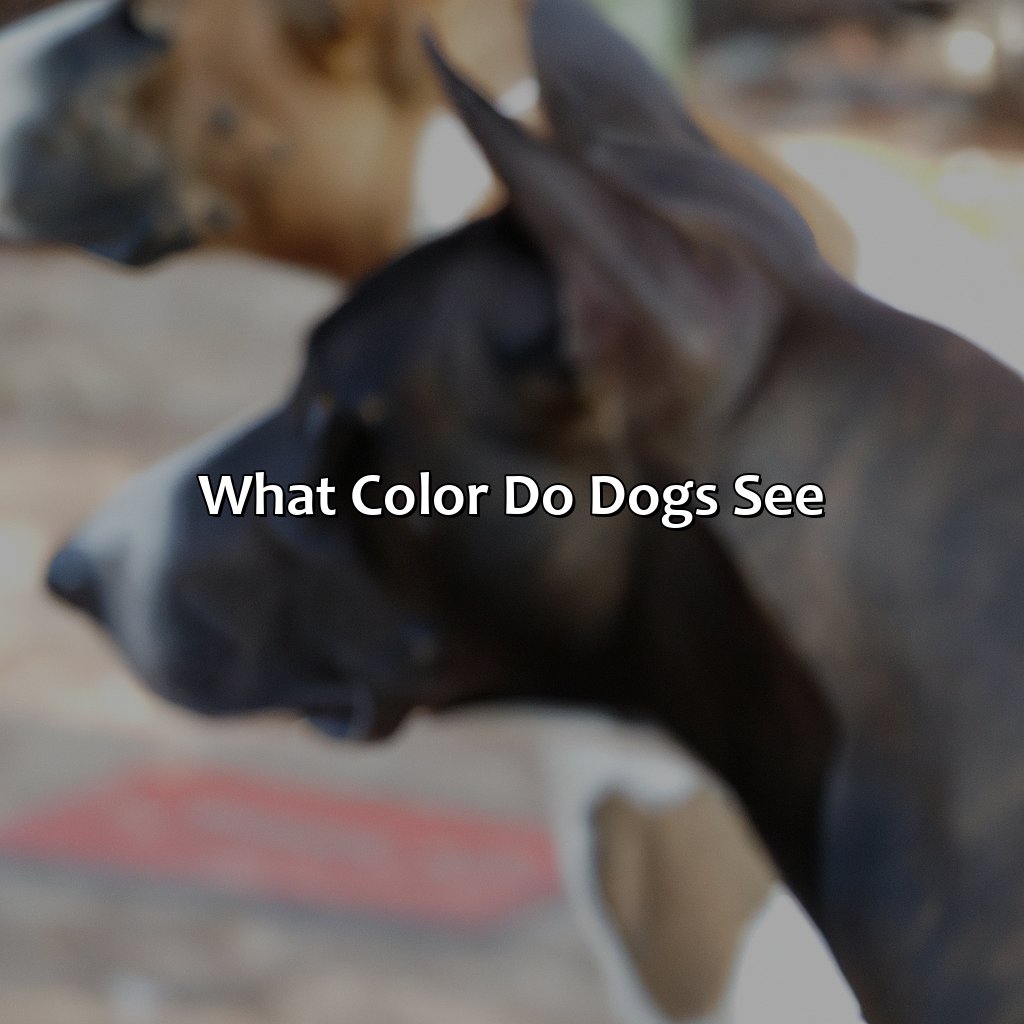Key Takeaway:
- Canine vision is different from human vision, and while dogs can see in color, they are not able to perceive the same range of colors that humans can.
- Dogs have a dichromatic visual system, which means that they have two types of cone cells in their eyes that allow them to see blue and yellow hues, but not red and green hues.
- Understanding color perception in dogs is important for training and communication, as color cues can be used to signal certain behaviors and commands. However, it is important to recognize the limitations of canine color perception in order to avoid confusion and effectively communicate with dogs.
Can Dogs See Colors?

Photo Credits: colorscombo.com by Jordan Moore
Dogs have limited color perception compared to humans, as they only possess two cones for color perception, while humans have three. Therefore, dogs are less likely to differentiate between certain colors. Canine vision is similar to red-green color-blindness in humans, and they have difficulty distinguishing between red and green hues. However, dogs possess better vision in low light conditions due to their higher number of rod cells.
It is crucial to understand canine color perception while training, as the color of an object can impact their response. Pro Tip: Use contrast and brightness rather than color cues while training dogs.
The Science of Color Vision

Photo Credits: colorscombo.com by Arthur Allen
To comprehend canine color sight, we must understand the science of visual perception. Let’s explore trichromatic and dichromatic vision and the color spectrum. This section will aid in understanding canine eyesight and color vision deficiency. We’ll also quickly touch on retinal cells and visible light spectrum – what they mean for dog color perception. Genetics and color vision theory will be looked at too.
Cone Cells in the Eye
Cone cells in the eye are specialized retinal cells involved in color vision and visual acuity. They come in three types, each tuned to a different wavelength range of visible light. The signals from multiple cone cells are combined by the retina to form a precise representation of the colors in an image, which is then sent to the brain through the optic nerve for further visual processing.
| Cone cell type | Wavelength sensitivity | Color Perception |
|---|---|---|
| S-cones | Short (blue) wavelengths | Blue-violet |
| M-cones | Medium (green) wavelengths | Yellow-green |
| L-cones | Long (red) wavelengths | Red-orange |
Interestingly, dogs have fewer cones than humans which affects their color perception and makes them more prone to color blindness. While humans have three different types of cones for detecting red, green, and blue light, dogs only have two types of cones.
Dogs do not see the world in black and white; instead, they live in a more muted and limited palette that is mainly based on blues and yellows with some shades of gray. Their primary colors are blue and yellow while reds and greens appear as variations of brown or gray. It is essential to understand this limitation while training or interacting with dogs since using color-coded tools may not be practical.
There was an infamous incident where researchers tried to feed colorful kibble to dogs only to discover that it did not appeal to them at all despite looking aesthetically pleasing for us humans’ consumption.The study highlighted how dogs’ preference for scent far outweighs their preference for color when it comes down to food selection.
Color perception in animals is a fascinating field, but I’m pretty sure dogs just see everything as shades of ‘squirrel’.
Visible Light Spectrum
The light spectrum visible to the naked eye consists of various wavelengths, each with a specific color. The human eye can perceive colors ranging from violet to red, while some animals can see beyond this range. The wavelengths in the visible light spectrum are crucial for color perception, an ability that differs across animal species.
| Science of Color Vision | |
|---|---|
| Animal | Color Range |
| Humans | Violet-Red |
| Dogs | Yellow-Blue |
Dogs’ color perception differs from humans due to their unique vision system. They have fewer cone cells in their eyes, responsible for differentiating colors, but their visual acuity is about four times less than that of humans.
Color perception testing has been conducted on dogs to understand their visual abilities. These tests determine the specific shades of colors they can differentiate and help understand how they perceive objects in their environment.
When training dogs or communicating with them, understanding their color perception is essential. Certain colors like yellow and orange are more visible to dogs than others, making them ideal for spotting objects during playtime or training sessions.
Dogs may not see the world in Technicolor, but their unique color perception still adds some fun to their otherwise black and white lives.
Understanding Color Perception in Dogs

Photo Credits: colorscombo.com by Ronald Baker
Time to get to know how dogs view the world! We’ll take a closer look at their peculiar color perception. We’ll examine color confusion, vision development, and colorblindness. What kind of colorblindness do dogs suffer from? How does their color vision compare to ours? These sub-sections will answer all your questions.
Types of Color Blindness in Dogs
Dogs have different types of color blindness that affect their perception of colors. This impairment is due to the absence or malfunctioning of cone cells in their eyes, which are responsible for detecting color stimuli. To better understand this condition, a table can be created showing the different types of color vision deficiency in dogs, the mutated gene associated with it, and the prevalence in certain breeds. This data can be found through extensive canine color confusion research.
| Type of Color Blindness | Mutated Gene | Prevalence |
|---|---|---|
| Monochromacy | CNGB3-1 | Rare |
| Blue Cone Monochromacy | CNGB3 | Rare |
| Rod Monochromacy | RPE65 | Rare |
While humans have three types of cone cells for trichromatic vision, dogs only have two. Thus, dogs do not perceive colors as vividly as humans do and may struggle to distinguish between certain hues, including green and red. However, canine color preference studies have shown that they respond positively to some colors such as blue and yellow.
Understanding how dogs perceive colors is important in various contexts. In training and communication, color cues can be effective tools since they are easy for dogs to see and remember. Additionally, visual cognition plays a crucial role in their hunting skills and prey drive. With this awareness on canine color theory, pet owners can provide better care for their furry companions.
Don’t miss out on learning more about how your dog sees the world around them – expand your knowledge on canine color vision research today!
The difference between our color vision and dogs’ is like watching a movie in 4K versus 480p.
Comparison of Humans’ and Dogs’ Color Vision
Humans’ and dogs’ color vision differs due to variations in the number and sensitivity of cone cells in their eyes. Canine vision is closer to red-green color blindness, with fewer cones than humans. Visual acuity testing has shown that dogs have better sensitivity to motion and contrast than color.
Comparison of Humans’ and Dogs’ Color Vision:
| Humans | Dogs | |
|---|---|---|
| Number of cones | 3 | 2 |
| Sensitive to Colors | Blue, Green, Red | Blue, Yellow |
Unique details about understanding canine vision include the fact that color psychology affects dogs differently since they rely more on other senses. Also, visual thresholds that are not detectable by humans can be quite visible to dogs.
Call-to-action: It’s essential to understand your dog’s unique visual perception for effective training and communication. Don’t miss out on exploring color psychology in dogs and visual acuity testing to better understand their vision.
From poodles to pugs, a dog’s breed can play a role in their color vision abilities, but colorblindness can also affect their perception of the world around them.
The Colors Dogs Can See and Can’t See

Photo Credits: colorscombo.com by Henry Flores
Unravel the mystery of dog vision! Understand their colorblindness and color perception. Check out our section “The Colors Dogs Can See and Can’t See”. It has sub-sections like “Colors Perceived by Dogs” and “Colors that Dogs Struggle to See”. Here, you’ll learn about a dog’s color detection ability, also how it changes with age, and its effect on dog training and competitions.
Colors Perceived by Dogs
Dogs have different color detection compared to humans due to differences in their cone cells. They have two types of cones, whereas humans have three. This means they perceive colors as less bright and less distinct. However, dogs can see some colors such as blue and yellow, but red and green appear gray or brownish. Color vision anomalies can also occur in certain breeds, affecting their perception of colors even more.
Color perception in dog training is important as it can aid communication between trainers and dogs. Training tools such as colored discs and dummies are used to help dogs differentiate between objects based on color. In some dog competitions, detecting specific colors may be necessary for performance tasks.
Interestingly, color vision also affects a dog’s hunting abilities. Dogs with poor color vision may struggle to identify prey based on its color, relying on other senses like scent instead.
A true history reveals that researchers discovered dogs’ limited color perception by testing their reactions to colored objects and lights. The experiments also revealed the existence of differing degrees of color blindness in various dog breeds. Overall, understanding dogs’ limited ability for distinguishing colors is crucial when training them or trying to understand their behaviors.
Dogs may struggle with seeing reds and greens, but they more than make up for it with their superior sense of smell.
Colors that Dogs Struggle to See
Dogs possess a limited color vision due to the number of cones in their eyes. Certain colors appear as washed out or greyish to them, with blue and yellow being the most noticeable. However, dogs have difficulty distinguishing between reds and greens, which can lead to confusion when training or communicating with humans. The concept of color vision changes with age, and canine visual function typically declines in old age. Additionally, dogs exhibit color vision adaptation wherein they learn to detect specific colors in certain situations, such as detecting skin tone changes in humans.
Who needs a rainbow when you have a dog with color vision to help you fetch the right ball?
The Impact of Color Vision on Dogs’ Behaviors

Photo Credits: colorscombo.com by Jason Thompson
We must study the importance of color vision in a dog’s behaviours, color distinction in dog sports, and color cues in dog training and hunting. This section – ‘The Impact of Color Vision on Dogs’ Behaviours’ – will discuss the role of color in training and communication. This includes color recognition training and canine color symbolization. We will also look at how color vision affects a dog’s hunting and prey drive, and the effects it has on their behaviour, emotions, and mood.
The Role of Color in Training and Communication
Color recognition training and canine color symbolization have been proven to be effective in communicating with our furry friends. Dogs can perceive colors, though not as vividly as humans, and studies suggest that they tend to prefer specific hues. Canine color preference study even shows that some breeds are more attracted to certain shades than others. Understanding the psychology of color in dogs can aid in training and communication, making it important for pet owners and trainers to consider the impact of color on their pets’ behavior and emotions.
Dogs see in color, but they’re not impressed – they’re more focused on how that color can help them catch their next meal.
How Color Vision Affects Dogs’ Hunting and Prey Drive
The visual sense of dogs affects their hunting and prey drives. Canines use color to identify prey, predators, and communication purposes. Due to their limited color perception, they rely on shape, brightness, intensity, texture, and motion detection instead of color to recognize objects or animals in the environment. However, research has proven that training techniques using colors can alter a dog’s behavior towards aggression, fear, and anxiety.
Color vision in dogs has an impact on their mood and emotion as well. For instance, blue light exposure is known to have a calming effect on dogs which can help to reduce separation anxiety. Similarly, incorporating red colors in toys or play activities can increase a dog’s excitement level.
Canine behavior modification through color is gaining popularity among pet owners who want to train their companions naturally without medication or punishment. Different colors are associated with certain emotions or moods in dogs such as calmness (blue), excitement (red), alertness (green), and friendliness (yellow). By using these color associations during training sessions, pet owners can effectively communicate with their canine friends.
The use of colors in canine behavior modification is not new as it has been used for centuries due to its symbolic significance in different cultures worldwide. For example, red symbolizes protection or warning whereas yellow represents warmth or hospitality. Pet owners can also incorporate these symbolic meanings into the dog’s environment by using colorful bedding sheets, toys, or collars.
Source: www.akc.org/expert-advice/training/color-vision-in-dogs/
Five Facts About What Color Do Dogs See:
- ✅ Dogs can distinguish between blue and yellow, but not between red and green. (Source: WebMD)
- ✅ The color perception of dogs is similar to that of red-green colorblind humans. (Source: Psychology Today)
- ✅ Dogs have more rods than humans, which make them better at seeing in low light conditions. (Source: American Kennel Club)
- ✅ Dogs have a wider range of peripheral vision than humans, but a smaller visual acuity. (Source: Merck Veterinary Manual)
- ✅ The colorblindness in dogs may have evolved as an adaptation to help them better detect changes in the color of the environment. (Source: Science Daily)
FAQs about What Color Do Dogs See
What color do dogs see?
Dogs do not see colors the same way humans do. They have two types of color receptors, while humans have three. Dogs can see shades of blue and yellow, but they cannot distinguish between red and green.
Do all dogs see the same colors?
Yes, all dogs have the same color vision. However, some dog breeds may have slightly better or worse vision than others, just like humans.
Why can’t dogs see red and green?
Dogs cannot see red and green because they lack the specific color receptors that humans have to distinguish between them. Instead, they see these colors as shades of gray.
What colors do dogs see best?
Dogs see shades of blue and yellow best. These colors are more vibrant to dogs and are easier for them to distinguish, while other colors may appear dull or washed out.
How does a dog’s color vision affect their behavior?
A dog’s color vision affects how they perceive their surroundings and can impact their behavior. For example, a bright red toy may be difficult for a dog to see, which could affect their willingness to play with it.
Can a dog’s color vision be improved?
No, a dog’s color vision is determined by their genetics and cannot be improved. However, dogs have other senses like smell and hearing that compensate for any limitations in their vision.






